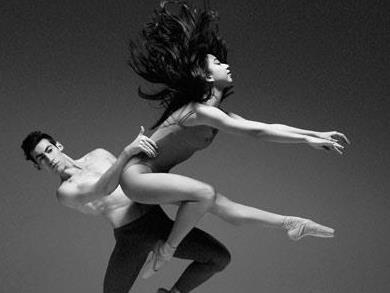‘Technique’ was the theme of the 2013 Australian Ballet Bodytorque season – an annual laboratory event which has provided a platform for new ideas in ballet for almost a decade. Selected choreographers use the time to discover new skills, to let loose and to experiment. This year we were treated to six short strong works that showcased the dazzling technique of these dancers.
What is meant by ‘technique’ and how did the various choreographers define it? The six short works give very different, thought provoking answers. Generally there was sparse, minimalist staging. Most of the works used classical ballet as a base and included Pointe work. Some of the music is performed live.
The programme opened with Benjamin Stuart Carberry’s sleek and sparse Polymorphia. It demanded impeccable enablement and a long, stretched line especially in arabesque and développé. Two dancers in black costumes were in circles of light (one turning inwards, one turning outwards – in ballet terms en dedans and en dehors), representing our conflicting inner selves. They have a mirroring /reflective dialogue and it concludes with sinuous, rippling arms and sizzling jumps. Carberry’s choreography is quite demanding and revealing, reminiscent of Balanchine and Kylian’s work.
The middle work of the first half was Tinted Windows by Alice Topp. In some ways it had a similar feel to the big pas de deux from Christopher Wheeldon’s ‘After the Rain’ – lyrical and romantic. There were lots of flowing, sliding movement – at times like skating – and writhing ecstatically. Some of the choreography reminded me perhaps of early Murphy, especially his ‘Sheherazade’ for example. There were some fiendishly difficult lifts and also of particular note was the same sex section of the pas de quatre that was striking and unusual.
Next came the quite sparse and abstract Mode.L as choreographed by Halaina Hills. Again, one could observe a Balanchine influence. There were tiny solos for each of the dancers and some very fast supported turns. It was clean, clear pure ‘dance’, playful, with the dancers clearly following the counts and rhythms of Stravinsky’s music almost as if they were an instrument .Of great interest was the use of Benesh notation screened as the background.
Richard Houses’ ‘Finding the Calm’ was dominated by the magnificent lighting by Graham Silver that effectively was the set. At times it had a clinical, futuristic feel but the opening section was full of yearning. Some of the choreography was almost contortionist and did I pick up allusions perhaps to Macmillan and Bonachela works. There was at one point a fabulous sculptural back bend and again some very fast supported turns. In this work the men were topless and there were very revealing white costumes for the women- a white fringed skirt that rippled in the bourree.
Ty King Wall’s The Art Of War was a big audience favourite. It began with rippling, pulsating, music and had some very effective, quite stylised choreography based on martial arts and capoeira. A low three level platform was the set. The men were in grey/green casual military like costumes (and at one point glow in the dark bodypaint ) and the choreography showed off their fast and furious whirling turns. The woman wore a Grecian style red dress. Some of the phrases of choreography were reminiscent of Graeme Murphy’s pas de deux major works; especially the runs and lift in the yearning melancholy pas de deux towards the end.
The final work, In-Finite by Joshua Consandine included lots of fast, fiddly batterie and demanded split second precision timing and very controlled unison work as well as yet more extremely difficult lifts. Lots of double tours for the men showed off their great prowess and there were very complicated group manoeuvres echoing the rhythms of the music, performed precisely on the beat. The individually detailed black tutus worn by the women were very short and extremely revealing. The set for this work included a large silver chime. Consandine’s work had a sense of humour and sent the audience home laughing.
The dancing was superb and there was something for everyone in this most exciting programme .
Running time 2 hours ( approx) including interval
4 stars
The Australian Ballet’s Bodytorque ‘ Technique’ runs at Sydney Theatre 31 Oct – 3 Nov 2013
Polymorphia
Choreography Benjamin Stuart-Carberry
Music Jonny Greenwood
Design Cordinator Kat Chan
Lighting Graham Silver
Tinted Windows
Choreography Alice Topp
Music Leif Sundstrup
Costumes Toni Maticevski
Lighting Graham Silver
Mode.L
Choreography Halaina Hills
Music Stravinsky
Design Cordinator Kat Chan
Lighting Graham Silver
Finding the Calm
Choreography Richard House
Music JCS Bach
Costume and design coordinator Kat Chan
Lighting Graham Silver
The Art of War
Choreography Ty King-Wall
Design Cordinator Kat Chan
Lighting Graham Silver
In-Finite
Choreography Joshua Consandine
Music – Vivaldi
Design Cordinator Kat Chan
Set design Cate Consadine
Lighting Graham Silver





